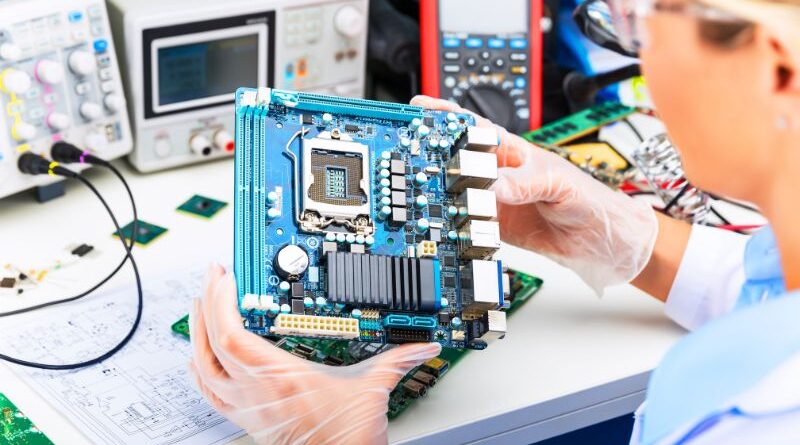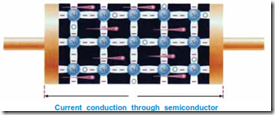
In an era where technology is seamlessly integrated into our everyday lives, electronic devices are the unsung heroes driving our digital age. From the devices we carry in our pockets to the vast interconnected networks that span the globe, electronics underpins every aspect of our modern world. Like a hidden symphony orchestrating our digital symposium, electronics is the heart of innovation, propelling humanity into an era of unprecedented technological advancement. In this exploration, we set out on a journey to uncover the fundamental principles of the electronic domain, from the generation and control of electrical energy to the conversion of light into electricity. It's a journey that reveals the workings of devices we take for granted, sheds light on the magic behind our connected world, and invites us to celebrate the ingenuity that has shaped our present and will shape our future. Welcome to “The Heartbeat of Innovation: Understanding the Principle of Electronics.”
Electronic devices and their use
At its core, the principle of electronics basically deals with electronic devices and their use. These devices are designed to manipulate the flow of electrical current, typically through a semiconductor material, gas, or even a vacuum. This controlled flow of electrons is at the heart of electronic functionality. These devices have remarkable features that allow them to perform countless functions in our lives today.

Importance of electronics
Due to the countless applications around the world, electronics have become increasingly important. The following functions can be performed using an electronic device. The importance of electronics cannot be underestimated. In a world connected by technology, electronic devices have expanded their influence across various sectors and industries. Electronics allow countless functions and applications, from the simplest calculator to the most complex supercomputer. Let's explore some of the key roles that electronic devices play in our daily lives:
Communication and Connectivity: Electronic devices form the backbone of modern communication. These devices, from smartphones to satellites, allow us to connect with people around the world, share information instantly and access the Internet.
Computer science and data processing: Computers, laptops, and servers rely on electronic components to process large amounts of data, perform complex calculations, and run software applications.
Healthcare and medical devices: Electronic devices play a critical role in healthcare, from diagnostic tools like MRI machines to life-saving devices like pacemakers and ventilators.
Transportation and Automobile: Modern vehicle electronic systems improve safety, efficiency and entertainment. From anti-lock brakes to navigation systems, electronics are an integral part of modern cars.
Entertainment and Multimedia: From high-resolution televisions to gaming consoles: electronic devices bring us joy and intense experiences like never before.
Renewable energy and sustainability: Electronics play a crucial role in harnessing renewable energy sources, such as solar panels and wind turbines, contributing to a more sustainable future.
Automation and Robotics: In industries ranging from manufacturing to agriculture, electronic devices power automation and robotic systems, increasing efficiency and productivity.
Aerospace and space exploration
Electronic systems are the lifeblood of spacecraft. They ensure that space missions are successful and that data is transmitted to Earth.
Correction
In electronics and electrical engineering, rectification converts alternating current (AC) to direct current (DC). Understanding rectification is critical to powering and controlling countless electronic devices, from your smartphone charger to your computer power adapter. This article examines rectification, its types, and its importance in modern electronics.

- Alternating current (AC): Alternating current is an electrical current in which the flow of electrical charge periodically changes direction. This means that voltage and current fluctuate in a sine wave shape and rise and fall in a cyclical pattern.
- Direct Current (DC): Direct current, on the other hand, is a constant, unidirectional flow of electrical charge. In DC circuits, voltage and current remain constant without changing direction over time.
The need for correction
Although many electronic devices are usually powered by direct current, the power supply for homes and businesses is usually alternating current. So why do we need to convert AC to DC?
- Direct Voltage: Direct current provides a stable, constant voltage, which is essential for the proper functioning of many electronic components.
- Charging the battery: Most rechargeable batteries, including those in laptops, smartphones and electric vehicles, require DC voltage to charge.
- Electronic equipment: Internal components of electronic devices, such as microprocessors, transistors, and integrated circuits, typically operate on DC voltage.
- LED Lighting: LEDs (light-emitting diodes) require DC voltage to emit light efficiently.
Correction types
A correction can be made in several ways. The most common methods are:
- Half-wave rectification: This method allows only half of the AC waveform to pass through, resulting in a pulsating DC output. This is simple, but not very efficient.
- Full-wave rectification: Full-wave rectification is more efficient because it allows the use of both halves of the AC waveform, effectively doubling the frequency of the resulting DC waveform. This can be achieved using diode bridges.
- Bridge Rectification: Bridge rectifiers are often used to convert AC power to DC power. They consist of diodes arranged in a bridge circuit, ensuring efficient use of the positive and negative halves of the AC waveform.
Reinforcement process
Amplification is a fundamental process in electronics that involves increasing the strength or strength of an electrical signal. This process is central to diverse applications, from audio and telecommunications to medical devices and industrial control systems. This article examines the principles of reinforcement, their importance, and the different methods for achieving them.
Importance of reinforcement
Reinforcement is important for several reasons:
- Signal amplification: In many applications, signals from sensors, microphones, or other sources are weak and must be amplified for proper processing or transmission.
- Communication: Amplifiers are crucial in communication systems to ensure that signals can travel long distances without significant loss of quality.
- Audio systems: Audio amplification involves amplifying weak audio signals from sources such as microphones or musical instruments to drive speakers and produce sound at the desired volume.
- Medical equipment: Medical instruments often process weak bioelectrical signals that need to be amplified for accurate diagnosis and monitoring.
- Industrial control: Industrial automation and control systems use amplification to process sensor signals and make decisions based on those signals.
Types of amplifiers
There are different types of amplifiers designed for specific purposes. Some common types are:
- Operational Amplifiers (Op-Amps): These versatile amplifiers are widely used in electronic circuits due to their high gain and accurate performance.
- Audio Amplifier: These include preamplifiers, power amplifiers and integrated amplifiers designed to amplify audio signals.
- Radio frequency (RF) amplifier: Used in communication systems to amplify radio signals.
- Instrument amplifier: Precision amplifiers are used in applications where precision and low noise are essential, such as medical devices and scientific instruments.
- Differential amplifier: These amplifiers amplify the difference between two input signals and are often used in measurement and instrumentation technology.

to control
Control is a fundamental concept in electronics and plays a crucial role in regulating and manipulating signals, devices and systems. Whether it's adjusting the volume on your stereo, regulating the temperature in your home, or piloting a spaceship through the cosmos, control systems are the invisible hand behind countless technological marvels. This article analyzes the principles of control in electronics, their importance and the different methods used for effective control.
Importance of control in electronics
- Precision and accuracy : Control systems ensure that electronic devices and processes operate with precision and accuracy, minimizing errors and deviations.
- stability : Control systems help maintain the functionality of electronic circuits and systems and prevent oscillation or uncontrollable behavior.
- automation : Many industrial processes, robots, and automated systems rely on control systems to function efficiently without human intervention.
- Energy efficiency : Control systems can optimize energy consumption, making electronic devices more energy efficient and environmentally friendly.
- Security : In critical applications such as automotive control systems and medical devices, control ensures the safety of users and devices.
Control methods and techniques
- Proportional-Integral-Derivative (PID) Control: A widely used control algorithm that adjusts the control signal based on the proportional, integral, and derivative values of the error signal.
- Digital control: Control systems that use digital processors and algorithms for precise control in applications such as microcontrollers and embedded systems.
- Fuzzy logic control: A control method that takes uncertainty and linguistic variables into account and is often used in complex, nonlinear systems.
- State space control: A mathematical approach to modeling and controlling dynamical systems, particularly in engineering and aerospace.
- Optimal control: Techniques such as linear-quadratic (LQR) control aim to optimize the control of a system to achieve a specific objective while minimizing a cost function.
generation
Electricity generation, often referred to as power generation, involves the conversion of a form of energy into electrical energy. This electrical energy is the lifeblood of modern civilization, powering everything from our homes and industries to transportation and communications networks. Electricity generation is primarily driven by the need for a reliable and readily available source of electricity.
Sources of electricity generation
Electricity can be generated from several sources, each with its own principles and technologies:
- Fossil fuels: Conventional power plants burn fossil fuels, such as coal, natural gas and oil, to produce steam that drives turbines connected to generators. This process is highly efficient, but is harmful to the environment due to emissions.
- Renewable energy: Renewable energy sources, such as solar panels, wind turbines and hydroelectric plants, use energy from natural phenomena such as sunlight, wind and running water. These sources offer environmentally friendly options and are becoming increasingly important.
- Nuclear power: Nuclear power plants use controlled nuclear reactions to produce steam, which, like in fossil fuel-powered plants, drives turbines to generate electricity. Nuclear energy is clean, but it also presents its own challenges in terms of safety and waste disposal.
- Batteries and energy storage: Electrical energy can be stored in batteries and later converted to electricity when needed, enabling portable devices and backup power.
Importance of efficient energy conversion
Efficiency is a primary concern in electricity generation. It determines how effectively the energy source is converted into electrical energy. High efficiency reduces waste and reduces operating costs and environmental impact. Technological advances continue to drive improvements in energy conversion efficiency and make production methods more sustainable and profitable.
Electricity generation methods
Electricity generation methods vary greatly depending on the energy source, but generally include the following steps:
- Energy conversion: The energy source (e.g. fuel, sunlight, wind) is converted into mechanical energy. This is usually done by turning a turbine.
- Mechanical energy to electrical energy: Mechanical energy is then used to rotate a generator made of coils of wire in a magnetic field. This movement induces an electric current in the wire, generating electricity.
Conversion of light to electricity
The importance of solar energy

Solar energy, which comes from the conversion of light into electricity, is extremely important for several reasons:
- Renewable and sustainable: Solar energy is a nearly unlimited and sustainable source of electricity because the sun's energy output far exceeds our current and future energy needs.
- Clean and environmentally friendly: Solar energy generation produces no greenhouse gases or pollutants, making it one of the cleanest forms of energy.
- Reduced energy costs: By installing solar panels on residential or commercial properties, you can significantly reduce your electricity bill and have a positive impact on your investment over time.
- Grid independence: Solar systems can be operated independently of the electrical grid and can therefore also supply electricity to remote or grid-independent locations.
- Space exploration: Photovoltaics are critical for space exploration, powering spacecraft and space stations in harsh environments.
Photovoltaic cell mechanisms
Photovoltaic cells use semiconductors, usually silicon, to capture solar energy and convert it into electricity. The basic components of a photovoltaic cell include:
- Photovoltaic material: This semiconductor material absorbs photons and creates electrons. Silicon is the most used material due to its efficiency and availability.
- PN Intersection: Photovoltaic cells have a pn junction, where the p-type semiconductor has an excess of positive charge carriers (holes) and the n-type semiconductor has too many negative charge carriers (electrons).
- Electrical contacts: Metallic contacts on the cell surface collect the generated electrons and provide an external circuit.
- Anti-reflective coating: To maximize light absorption, a thin anti-reflective coating is applied to the surface of the photovoltaic material.
Conclusion
In the ever-evolving landscape of modern technology, understanding the principles of electronics is the same as deciphering the heart of innovation. Electronics are the silent architect of our connected world and shape our lives in profound and subtle ways. From the tiny microchips in our everyday devices to the colossal systems that control our global communications, the principle of electronics is the catalyst of progress, the enabler of convenience and the guardian of precision.


